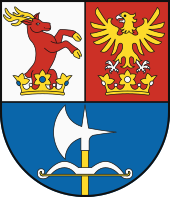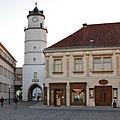Trenčín Region
Trenčín Region
Trenčiansky kraj | |
|---|---|
 | |
 | |
| Country | Slovakia |
| Capital | Trenčín |
| Government | |
| • Body | County Council of Trenčín Region |
| • Governor | Jaroslav Baška (SMER–SD) |
| Area | |
• Total | 4,502.08 km2 (1,738.26 sq mi) |
| Highest elevation | 1,346 m (4,416 ft) |
| Lowest elevation | 195 m (640 ft) |
| Population (2023)[1] | |
• Total | 569,388 |
| • Density | 130/km2 (330/sq mi) |
| GDP | |
| • Total | €7.546 billion (2016) |
| • Per capita | €12,803 (2016) |
| Time zone | UTC+1 (CET) |
| • Summer (DST) | UTC+2 (CEST) |
| ISO 3166 code | SK-TC |
| Website | www |
The Trenčín Region (Slovak: Trenčiansky kraj, pronounced [ˈtrentʂɪɐnski ˈkraj]; Czech: Trenčínský kraj; Hungarian: Trencséni kerület) is one of the eight Slovak administrative regions. It consists of nine districts (okresy). The region was established in 1996: previously it had been a part of the West Slovak Region (Západoslovenský kraj) and partly the Central Slovak Region (Stredoslovenský kraj). Industry is a major sector of the region's economy.
Geography
[edit]It is located in north-western Slovakia, has an area of 4,502 km2 and a population of 600,386 (2005). The Danubian Lowland reaches the region to Nové Mesto nad Váhom and Partizánske areas. There are several mountain ranges in the region: a small part of the Little Carpathians in the south-west, White Carpathians in the north-west, Maple Mountains in the north, Strážov Mountains in the centre, Považský Inovec in the south, Vtáčnik in the south-east and Žiar in the east. Small parts of Lesser Fatra and of the Kremnica Mountains also stretch to the region. Major rivers are the Váh in the western part of the region, creating the so-called Váh Basin and Nitra in the south-east and east, creating the Upper Nitra Basin. The Myjava River springs in the west, but flows into the Trnava Region. The region borders Žilina Region in the north-east and east, Banská Bystrica Region in the south-east, Nitra Region in the south, Trnava Region in the south and south-west, Czech South Moravian Region in the west and the Zlín Region in the north-west and north.
Demographics
[edit]| Year | Pop. | ±% |
|---|---|---|
| 1970 | 515,916 | — |
| 1980 | 568,498 | +10.2% |
| 1991 | 600,575 | +5.6% |
| 2001 | 605,582 | +0.8% |
| 2011 | 594,328 | −1.9% |
| 2021 | 577,464 | −2.8% |
| Source: Censuses[3][4] | ||
The population density is 129/km2 (330/sq mi) (2020-06-30/-07-01),[5] which is more than Slovak average (110 per km2), and the second highest after the Bratislava Region. The largest towns are Trenčín, Prievidza, Považská Bystrica, Dubnica nad Váhom and Partizánske. According to the 2001 census, the region had 605,583 inhabitants, with Slovaks forming a relatively homogeneous majority (97.3%), with a small minority of Czechs (1%) and others.[6]
Politics
[edit]Current governor of Trenčín region is Jaroslav Baška (Smer-SD). He won with 67.25 %. In election 2022 was elected also regional parliament :
County Council of Trenčín region | |
|---|---|
 | |
| Type | |
| Type | |
| Houses | County Council |
| Leadership | |
Governor | |
| Structure | |
| Seats | 44 |
 | |
Political groups |
|
| Elections | |
Last election | 29 October 2022 |
| Meeting place | |
| Governor's office, Trenčín | |
| Website | |
| Council of Trenčín region | |
2017 elections
[edit]| Political party | Seats won | Percentage | |
|---|---|---|---|
| Independents | 22 / 47
|
46.8 % | |
| Coalition led by Smer-SD | 16 / 47
|
34.0 % | |
| Centre-right coalition | 9 / 47
|
19.2 % | |
Administrative division
[edit]The Trenčín Region consists of 9 districts: Bánovce nad Bebravou, Ilava, Myjava, Nové Mesto nad Váhom, Partizánske, Považská Bystrica, Prievidza, Púchov, and Trenčín.
There are 275 municipalities (obce), including 18 towns, where about 58% of the region's population live.
Sport
[edit]Slovak bandy has its base in the region. Trenčianske Teplice is the seat of Slovak Bandy Association[10] and rink bandy sessions have been organised in for example Púchov[11] and Nové Mesto nad Váhom.[12]
Places of interest
[edit]- Trenčín with Trenčín Castle, City Gate, Trenčín Synagogue, Roman inscription on the castle rock in Trenčín, etc.
- The Tomb of Milan Rastislav Štefánik on the Bradlo above Brezová pod Bradlom
- Beckov Castle
- Trenčianske Teplice - a historical spa town
- Skalka pri Trenčíne monastery
- Castles in Šimonovany, Brodzany and Veľké Uherce
- Bojnice with Bojnice Castle, Bojnice Zoo, etc.
- Lednica Castle
- Manínska Gorge
- Little Carpathians Protected Landscape Area
- White Carpathians Protected Landscape Area
- Ponitrie Protected Landscape Area
- Strážov Mountains Protected Landscape Area
Gallery
[edit]-
Trenčin Castle above the Hotel Tatra (Elisabeth)
-
Lower Gate, Trenčín
-
Trenčín Synagogue, Trenčín
-
Roman inscription on the castle rock in Trenčín
-
Skalka pri Trenčíne monastery
-
Šimonovany Castle, Partizánske
-
Veké Uherce Castle, Veľké Uherce
-
Bojnice Castle, Bojnice
-
Bojnice Zoo, Bojnice
-
Lednica Castle, Lednica
-
Milan Rastislav Štefánik tomb on the Bradlo, Brezová pod Bradlom
-
Čachtice Castle, Čachtice
See also
[edit]References
[edit]- ^ "Number of inhabitants by gender (annually)".
- ^ Regions and Cities > Regional Statistics > Regional Economy > Regional GDP per Capita, OECD.Stats. Accessed on 16 November 2018.
- ^ "Statistical lexikon of municipalities 1970-2011" (PDF) (in Slovak).
- ^ "Census 2021 - Population - Basic results". Statistical Office of the Slovak Republic. 2021-01-01.
- ^ "Statistic of Slovak places by Dušan Kreheľ – Export". Retrieved 2021-07-05.
- ^ POPULATION AND HOUSING CENSUS 2001 - Tab. 3a
- ^ Direction, SNS, Voice, SR
- ^ SaS, Together, Chance, ODS, DS, KDH, OKS, DVaU
- ^
- STANK (1)
- ^ "Google Translate".
- ^ Poster for a rink bandy session in Púchov [dead link]
- ^ Poster for a rink bandy session in Nové Mesto nad Váhom[permanent dead link]
- Kopa, Ľudovít; et al. (2006). The Encyclopaedia of Slovakia and the Slovaks. Bratislava, Slovakia: Encyclopaedic Institute of the Slovak Academy of Sciences. ISBN 80-224-0925-1.

























